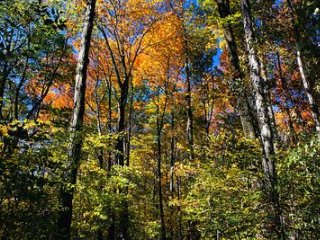Ulysses Samuel Lesh was born to Joseph and Sarah
Lesh of Wells
County in 1868. As a child, Lesh was shy and spent much
of his time hunting and fishing. He graduated from the University
of Michigan in 1892 and began work at a law firm in Huntington,
Indiana. In 1894 Lesh married Minnie Ursula Fulton, with
whom he had six children. His political career led to the
development of his own practice and a position as the Huntington
City Attorney, but he was always known by his peers as being
much more interested in writing. This interest led to the
publication of two novels. The first, A Knight of the
Golden Circle, concerns the celebrated treason trials
of the Civil War. The latter, Three Profiteers, explains
an economic theory through narrative and dialogue.
In
A Knight of the Golden Circle Lesh
tells of the beauty of the Hoosier forest as two characters
saunter through it. His homage to the individual tree species
and their charming characteristics shows a respect and love
for the forest:
[T]hey plunged into the deep of the forest,
and soon found themselves hid even from the stars by the
density of the foliage; for here, in one grand assemblage,
were found the huge and mighty oak; the tall and stately
poplar, and its sister, the ash; the spreading, graceful
elm; the rough and rugged hickory; the close barked and
compact beech; the beautiful maple; with here and there
a walnut or a wild cherry, each excelling in some particular
virtue, and vying with the others to present the most beautiful
foliage to the starry eyes above, from whence they all received
the gentle dews and balmy airs with which they made their
variant tints and frills. (16)
 |
| A typical
Hoosier forest canopy remnant |
Lesh concludes this passage with the assertion
that "[t]his, indeed, was a typical Hoosier forest—the
Hoosier forest that was" (16). The archetypal forest
of Indiana is not disappearing; it already has disappeared.
In
Three Profiteers Lesh gives a bittersweet
description of rural life in Indiana, highlighting varied
human responses to nature's power. For example, he describes
the harsh effects of a late summer drought, but then counters
with the ironic benefits of such harshness, in the face of
industrialization:
August in the country is a somber month. It
brings with it the first pronounced proof of the brevity
of life. The meadows turn brown; the foliage loses its glossy
green; the flowers fade, and all nature proclaims the approaching
end of the life that comes and goes with spring and fall,
as the years go rolling by in the endless cycles of time.
Even the plaintive song of the dove perched in a tree at
the break of day, and the cry of the whip-poor-will as it
wings about at eventide, sound like solemn strains of Nature's
funeral dirge. Perhaps it is the effect of these annual
climatic changes on the things terrestrial that tends to
sober the mind, temper the soul, and strengthen the character
of the rural folks and make them that necessary stabilizing
influence when the social storms of the industrial centers
sweep the country with menacing force. (17)
Lesh also gives a sharp analysis of issues facing
Indiana in the early twentieth century: erosion
and destruction of its forests
and wetlands.
His stance on the benefits of the land's natural state and
his explanation of how those resources were being destroyed
show a great understanding of the natural systems of the land:
Through the exhaustive felling
of our huge native forests
and the clearing
of our lands, new problems have arisen. To mention some
of them, we find that in the denuding of these vast lands
for the plough and reaper, and later crisscrossing the fields
with a network of drainage
to quickly carry away the surface water, we have not only
dried up the living springs that were a source of great
joy and comfort to the pioneer settlers, but also have precipitated
a process of erosion
that is destroying the fertility of the lands, filling the
streams with silt, and causing devastating floods in the
valley regions.... In this way, according to a recent government
report, there is carried away annually from the surface
lands about three hundred and fifty million tons of silt,
and in the same report it is estimated that through this
erosion the lands are being stripped of twenty times as
much of their vegetation-producing fertility as is taken
up in the crops produced thereon. It also has become apparent
that not all of these cleared lands are needed for cultivation
purposes, and the timber shortage has added to the difficulties
of the farming industry. (194-95)
The loss of topsoil, and the mismanagement of
farm and timber lands, was a problem then, as now. Lesh poses
the rhetorical question, "[H]as the development of our
natural resources proven such an unmixed blessing as generally
believed?" (194). His answer: no.
This theme reoccurs throughout Lesh's two novels.
His words show not only affection for the natural world, but
an understanding of its importance and the effects that destruction
and alteration have on Hoosier life. It appears that Ulysses
Lesh had nostalgia for the Indiana environment before pioneers
as well as the vision to realize the tribulations of the future.
It was through his entertaining novels that he was successful
at introducing these environmental issues to Hoosiers.
Sources:
Bash, Frank Sumner. History of
Huntington County, Indiana: A Narrative Account of Its Historical
Progress, Its People, and Its Principal Interests. Chicago:
Lewis Pub. Co., 1914.
Lesh, Ulysses Samuel. A Knight
of the Golden Circle. Boston: Gorham, 1911.
---. Three Profiteers. Boston:
Stratford Co., 1934.
Image:
Lesh, Ulysses Samuel. A Knight
of the Golden Circle. Boston: Gorham, 1911.
|




